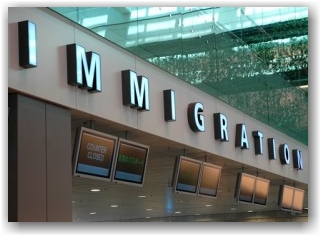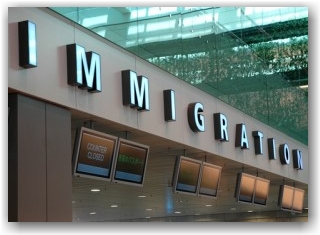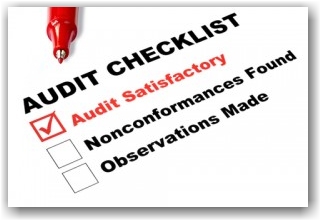Posts Tagged ‘E-Verify’
Thursday, October 10th, 2013

On June 15, 2012, President Obama signed a memo calling for deferred action for certain undocumented young people who came to the U.S. as children and have pursued education or military service here. Applications under the program which is called Deferred Action for Childhood Arrivals (“DACA”) began on August 15, 2012. Individuals that meet particular criteria, are awarded employment authorization (a/k/a an “EAD Card”) by USCIS.
USCIS does not alert employers when EAD cards have been issued to existing employees, and the employee is under no obligation to present the document to the employer. However, should they do so, the employer is obligated to examine the document.
The Attached Fact Sheet identifies the employer’s obligations during the Form I-9 process and provides specific guidance to employers on the treatment of EADs issued by USCIS to DACA recipients, whether they be current employees who come forward on their own, or new hires.
Note that DACA guidance does not direct employers to perform E-Verify queries on current employees who present DACA work authorization. Rather, it states that employers should complete a new Form I-9 and perform an E-Verify query in certain situations involving material changes to identity information. More on this topic can be found in the new M-274 Handbook on pages 23-24.
Should you like to become a client of our office or have particular questions pertaining to this topic, please feel free to contact us.
Tags: DACA, DACA EAD Cards, DACA Fact Sheet, DOL, E-Verify, EAD Employment Authorization, I-9 AUDIT, I-9 Form, I-9 Reverification, I-9 Training, I-9/E-Verify News, ICE, Immigration News, Legal Workforce, M-274, OSC, SSA, USCIS
Posted in DACA | DAPA, Department Of Homeland Security (DHS), Department Of Labor (DOL), Employer Compliance, I-9/E-Verify News, ICE, Immigration News, OSC, Social Security | Comments Off on Form I-9 Processing for DACA Recipients
Sunday, October 6th, 2013
 The Immigration and Nationality Act (“INA”) prohibits employers from discriminating against individuals based on their citizenship or immigration status, or based on their national origin, in the Form I-9 process. It is important for employers to develop, implement and enforce anti-discrimination policies, practices and procedures, and to ensure that all employees conducting Form I-9 verification or E-Verify confirmation understand all program rules. Employers should also provide appropriate and adequate employee education on employer responsibilities and worker rights.
The Immigration and Nationality Act (“INA”) prohibits employers from discriminating against individuals based on their citizenship or immigration status, or based on their national origin, in the Form I-9 process. It is important for employers to develop, implement and enforce anti-discrimination policies, practices and procedures, and to ensure that all employees conducting Form I-9 verification or E-Verify confirmation understand all program rules. Employers should also provide appropriate and adequate employee education on employer responsibilities and worker rights.
To prevent discrimination, employer’s should treat all people equally when
- announcing a job
- taking applications
- performing interviews
- making job offers
- verifying the individual’s authorization to work
- hiring the individual
- terminating the individual’s employment
Employers also must not retaliate against a person who
- files a charge of discrimination with OSC or EEOC
- participates in an investigation or prosecution of a discrimination complaint
- asserts his or her rights or the rights of another person under anti-discrimination laws
The Department of Justice’s Office of Special Counsel for Immigration-Related Unfair Employment Practices (OSC) investigates charges of employment discrimination related to an individual’s citizenship or immigration status or national origin. The Equal Employment Opportunity Commission (EEOC) also investigates employment discrimination based on national origin, in addition to other protected bases. OSC investigates national origin claims against employers with four to 14 employees, and EEOC investigates national origin claims against employers with 15 or more employees.
There has been a high level of enforcement by OSC this year concerning the anti-discrimination provision, with three more cases recently publicized in the last month:
- OSC settled with Texas-based Infinity Group who required non-citizens present specific DHS-issued documents such as green-cards or employment authorization to establish identity and employment authorization while similarly not requesting the same of US citizens. They were fined $53,000, had to pay $35K in back pay to those who were damaged as a result of their practices.
- OSC settled with PA-based Huber Nurseries for engaging in citizenship discrimination by preferring to hire temporary H-2A visa holders over Permanent Residents (green-card holders). Huber has agreed to pay $2,250 in civil penalties to the USA and $59,617 in back pay to the six injured parties, who are former refugees; and
- OSC settled with IBM for violating the anti-discrimination provision for placing online job postings for software developers with a preference for F-1 and H-1B visa holders. IBM has agreed to pay $44,400 in civil penalties to the USA.
So, what’s an employer to do?
Employers must accept all documents that are indicated on the List of Acceptable Documents to complete the I-9 form as long as they appear reasonably genuine on their face and relate to the employee. For example, all individuals who possess a driver’s license and unrestricted Social Security card may present those documents to satisfy Form I-9 requirements. Employers may not request or require potential employees to produce “green cards” or United States citizens who look or sound “foreign” to produce birth certificates. The employee chooses which of the acceptable Form I-9 documents to present. Employers must assure that those charged with the responsibility of I-9 management are trained on I-9 regulations and the anti-discrimination provision of the INA – and they must not
- Demand that an employee show specific documents
- Ask to see employment authorization documents before an individual accepts a job offer
- Refuse to accept a document, or refuse to hire an individual, because a document will expire in the future
- Refuse to accept a receipt that is acceptable for Form I-9 purposes
- Demand a specific document when reverifying that an employee is authorized to work
We recommend that you take some time and read the OSC’s Guide to Fair Employment that can be accessed here, that contains some thought provoking What would you do? scenarios that start on page 6.
Should you have questions or require particular guidance on this topic, please feel free to contact our office.
Tags: Department Of Homeland Security (DHS), E-Verify, Employment Practices, Hiring Practices, I-9 Audits, I-9 management, I-9 Penalties, I-9/E-Verify News, ICE, ICE Fines, Immigration News, INA Anti-Discrimination Provision, Legal Workforce, OSC, SSA
Posted in Department Of Homeland Security (DHS), Employer Compliance, I-9/E-Verify News, ICE, OSC, Social Security, USCIS | Comments Off on I-9/E-Verify: Preventing Discrimination in Hiring Practices
Monday, June 17th, 2013

After considering some 200 amendments to the Gang of 8’s immigration bill entitled the Border Security, Economic Opportunity, and Immigration Modernization Act of 2013 (a/k/a CIR, or Comprehensive Immigration Reform), it survived the Senate Judiciary Committee overhaul and has been introduced onto the floor of the Senate for further debate taking place this month. It is the goal of the Senate to complete their work on the Bill by the July 4th recess. On the weekend talk show circuit, Lindsay Graham (S-SC) told conservatives who are trying to block the measure that they will doom the party. Sen. Robert Menendez, D-N.J., went a step further and predicted “there will never be a road to the White House for the Republican Party if immigration overhaul fails to pass.”
The big question is – will the House of Representatives cooperate and pass a bill? The theory on this is that the purpose of the legislative process right now is for the House to get a bill passed. It could be a good or bad bill; it just has to be an intact bill because once something makes it through the House, it will go to conference with the Senate and the Committee will compare the two bills and draft a compromise bill that both chambers can accept
The Temperature on Immigration Reform in the House of Representatives:
While many House conservatives agree immigration reform is a critical priority for Congress, they part with President Obama, Senate Democrats, and some in their own party who believe allowing eventual citizenship to those in the country illegally is part of the solution. They vow that they won’t support any bill that adds to the deficit and they want to see a tougher approach to border security and to the benefits issue.
Not only has the federal government consistently increased spending on border enforcement, it has also met the border-security benchmarks laid down in the three immigration-reform bills introduced in the Senate since 2006. Read more on border security here
The GOP insists that newly legalized workers now working in the shadows have no access to government-sponsored health care during their 15-year pathway to citizenship. Democrats say that since these newly legalized immigrants would be paying taxes (millions already do pay taxes), they should be eligible for benefits.
In the end, both chambers of Congress must eventually pass the identical legislation for the bill to make its way to the President’s desk to become law. The question is…Will House Republican leadership pass a bill or fail?
White House Official stated to the Daily Caller, “If a Gang of Eight-style bill is signed into law by the President, it will probably be one of the top five legislative accomplishments in the last twenty years.”
For a Summary of S 744 refer here. Refer here for more on the progress of S. 744 in the Senate, the text of bill, the summary and the proposed amendments.
The House Judiciary Committee markup of the bill starts this week, and will start with SAFE Act (H.R. 2278), a bill to improve the interior enforcement of our immigration laws and strengthen national security and will then take up the AG Act (H.R. 1773), a bill to provide American farmers with a workable temporary agricultural guest worker program that will help provide access to a reliable workforce. Read more here
Tags: Agricultural Workers, Blue Card, border security, Border Security Economic Opportunity and Immigration Modernization Act of 2013, CIR, Comprehensive Immigration Reform, Congress, DACA, E-Verify, Employment Eligibility Verification, H-1B, Immigrant Benefits, Immigration Reform, S. 744, W visa
Posted in Agriculture, Comprehensive Immigration Reform, Congress, DACA | DAPA, Employer Compliance, H-1B Visas, Immigration Legislation, Immigration News, Social Security | Comments Off on The Heavy Lift of Immigration Reform
Thursday, February 28th, 2013

House Judiciary Committee holds Hearing Feb 27, 2013 on E-Verify to determine how it works and how it benefits American employers and workers
Areas of discussion were:
- Penalties for using E-Verify as a Pre-Screening Tool: Doing so is abuse of the system and totally prohibited, although at this time there are no penalties for pre-screening candidates prior to the acceptance of a job offer. The Monitoring and Compliance Unit of USCIS has indicated that they do indeed investigate employer usage particularly when there are patterns of abuse, and can be referred to OSC.
- The panel discussed that Mandatory E-Verify as part of a CIR bill should not require employers to verify their entire workforce – but just their existing employees.
- Identity Fraud: the Social Security Administration is working on a fix to identity fraud whereby one will be able to lock in their SS# to prevent multiple usage of numbers. SSA anticipates that this feature will be ready to roll out by the end of the year. As it stands now, a prospective employee can present fraudulent documents for the entire I-9 process for all 3 lists and be ‘work authorized’.
Further discussion ensured regarding the “phase in” process and whether or not the national usage mandate should become effective with the existing system while changes are implemented or wait until the system is further perfected. Additional discussion took place around establishing an official procedure for those workers who have been terminated due to incorrect Final Non-Confirmation (FNC) notices so that they can rectify the incorrect data.
The following is a statement by Rep. Gutierrez:
“Today’s hearing is remarkable because we are talking about employment verification systems in their proper context. We are discussing how to actually make them work and work for American workers with the right sorts of protections and appeals processes that make sure any errors are corrected in a timely manner. And we are talking about electronic verification systems as part of a broader reform that legalizes the current workforce and allows for legal immigration in the future.”
There’s certainly more to track as discussions ensue, and we will keep you posted on this topic.
Tags: Comprehensive Immigration Reform, E-Verify, E-Verify Final Non-Confirmation, House Judiciary Committee Hearing on E-Verify, Identity Fraud, Immigration Reform, Mandatory E-Verify, Rep. Gutierrez, Social Security Card, SSA, USCIS
Posted in Congress, Employer Compliance, Federal Contractors, I-9/E-Verify News, ICE, Immigration Legislation, Immigration News, OSC | Comments Off on How does E-Verify Fit into Comprehensive Immigration Reform?
Monday, January 28th, 2013

A group of 8 bipartisan senators have reached a deal on the outline of a comprehensive immigration overhaul, a development that is long overdue and will assist in framing the forthcoming immigration debate in Congress. Senator Schumer has stated that it is their plan that this can be turned into legislation by March and put into law by mid-late summer 2013.
According to a five-page document released today, the proposal provides a broad-based approach, agreed to in principle by eight senators, that seeks to overhaul the immigration system and create a pathway to citizenship for the nation’s roughly 11 million illegal immigrants.
Although all that we have focused on for years now is nothing else but border and enforcement issues and employment verification, the proposal takes enforcement to the next level by perfecting an entry/exit tracking system, and greater usage of E-Verify or a new and improved E-Verify system that is referred to as “fast and reliable.”
Legislators will create a commission comprised of border governors, attorneys general and community leaders living along the southwest border to monitor the progress of securing the border and to make a recommendation regarding when the bill’s security measures outlined in the legislation are completed.
While security measures are put in place, those who came and remained in the USA without permission, will be required to register with the government. This will include background checks, paying a fine and back taxes to earn probationary legal status to continue to live and work legally in the USA.
Once enforcement measures have been completed, those in probationary legal status will be required to go to the back of the line to wait their turn, pass an additional background check, pay taxes, learn English and civics and demonstrate a history of work in the US and current employment, among other requirements, to earn the opportunity to apply for lawful permanent residency (green-card) status. Those who successfully complete these requirements can eventually earn a green-card (legal permanent residence).
Special provisions will be accorded to the Dreamers (minor children who did not knowingly choose to violate any immigration laws) who will have different requirements that will include a pathway to citizenship.. Individuals who have been working illegally in the agricultural industry performing difficult work for low wages to ensure the safety of the food supply of the US will also be provided special requirements and will have a pathway to citizenship.
Those who graduate from an American University with a Ph.D or Master’s Degree in science, technology, engineering or math (STEM), will be awarded permanent residency (green-card status) to keep the best and brightest talent in the USA.
There are also provisions for a guest worker program referred to as “lower-skilled workers” in the proposal that will meet the needs of employers, the agricultural industry, including dairy, to find agricultural workers and lower skilled immigrants when the economy is creating jobs and fewer when the economy is not creating jobs. If this is the H-2B program, we sincerely hope that it gets an overhaul – it’s entirely too complicated, takes too long and completely discourages employers by overburdening them with excessive details.
Resources
Please see the senator’s attached Transcript. It’s certainly a an introduction to a long-awaited immigration conversation that is achievable – but difficult. A link to a transcript from the President’s speech in NV; and the President’s Immigration Fact Sheet.
What are the differences between the Senate and Obama Plan?
Tags: Agricultural Workers, Border Patrol, border security, Comprehensive Immigration Reform, E-Verify, Employment Eligibility Verification, Entry/Exit System, Guest Worker Program, IMMIGRATION ENFORCEMENT, Immigration News, Immigration Reform, Legal Workforce, Obama NV speech, STEM Students, Unskilled Workers, WORKPLACE ENFORCEMENT
Posted in Agriculture, Comprehensive Immigration Reform, Congress, Immigration Legislation, Immigration News | Comments Off on Senators Pitch Immigration Compromise
Sunday, December 30th, 2012

As 2012 winds down, with year-end planning sessions and budget meetings for 2013, how would you rate your company’s employment eligibility compliance program, as it stands right now? We are not in the bubble bursting business, but we’ve yet to see a compliance program that doesn’t need some upgrading and refinement – no one’s is perfect.
According to new data from ICE, since 2007, employer I-9 audits have increased from 250 to more than 3,000 in 2012. From fiscal years 2009 to 2012, the total amount of fines grew to nearly $13 million from $1 million. Statistics released by ICE in July 2012 stated that overall, $87.9 Million in fines have been imposed on employers for violations. The number of company managers arrested has increased to 238. Widespread employer audits will continue to increase this year. Plain and simple, failing to comply with IRCA’s I-9 rules will continue at a rapid rate, resulting in significant fines, loss of access to government contracts, an onslaught of negative publicity, business closure, criminal penalties and imprisonment.
With all the advice, blogs and articles written about the most complicated 1-page form on the planet, there are some basics – a simple formula that, if implemented, followed and maintained, will greatly enhance your level of I-9 compliance and reflect your company’s genuine desire to get its compliance house in order. This is what we recommend:
- Invest in a comprehensive I-9 audit by a knowledgeable attorney or professional who actually practices in this area of the law. Don’t engage in a self-audit without participating in a thorough training program first. This will cause more harm than good; it’s like the blind leading the blind.
- Following the audit and the review of your report of findings, get trained before the correction process begins. Who should be trained? All those who have hands-on exposure to the I-9 process at all of your organization’s locations…and all those who supervise the process and staff. Make training and reading the M-274 Employer Manual absolute requirements for those assigned to I-9 processing and management.
- Establish a written Compliance Policy. This does not need to be a huge undertaking, but should reflect your company policy concerning the steps you’ve taken to assure a compliant workforce and a culture of compliance at your organization. It will be your road map and reflects that you take compliance seriously. ICE will request this document, amongst many others, should they ever come knocking on your door.
- Appoint a Compliance Guru – one who has a senior level of knowledge, who will monitor your internal compliance program, review your I-9 forms every few months for accuracy and completeness, provide updates and arrange for refresher training on a yearly basis.
- Consult with a trusted professional in the field when questions or challenges arise – don’t guess.
Remember, the key to defending any employment related investigation is to evidence that there is and has been a consistent pattern of responsible, good faith effort on the part of the employer in establishing a compliant workforce. Stay informed, subscribe to our Blog, newsletter, and join in the conversation on our LinkedIn Group I-9/E-Verify: Smart Solutions for Employers. Check out our compliance services and solutions here, and make a concerted effort this year to increase your level of compliance by following the above formula.
Tags: Compliance Policy, E-Verify, Employment Eligibility Verification, I-9 AUDIT, I-9 Form, I-9 Immigration Compliance, I-9 Training, I-9/E-Verify News, ICE, ICE Audit, Immigration compliance, Immigration News, Legal Workforce, Mandatory E-Verify, USCIS
Posted in Comprehensive Immigration Reform, Employer Compliance, I-9/E-Verify News, ICE, Immigration Legislation, Immigration News, OSC, USCIS | Comments Off on I-9/E-Verify: 2013 Compliance Considerations for Employers
Wednesday, December 5th, 2012

As follows:
•Georgia: Companies employing more than 10 persons must register for E-Verify by July 1, 2012.
•North Carolina: Companies employing more than 100 persons must be registered for and using the E-Verify system on January 1, 2013.
•Pennsylvania: State contractors and sub-contractors must register for E-Verify beginning January 1, 2013 – but only if the project is greater than $25,000.
•Tennessee: Companies employing more than 5 persons must register and begin using E-Verify by January 1st.
Businesses within the above 4 states will need to collect an employee’s Social Security number and E-Verify all candidates before employing.
For more on E-Verify by state, we link here, compliments of LawLogix (www.lawlogix.com).
Tags: E-Verify, E-Verify by State, E-Verify State Regulations, EAD, Employment Eligibility Verification, Federal Contractors, I-9 Form, I-9/E-Verify News, Legal Workforce, New E-Verify State Regulations, Work Authorization
Posted in Federal Contractors, I-9/E-Verify News, ICE, Immigration News | Comments Off on REMINDER: New E-Verify Laws; Some go into Effect January 1, 2013
Friday, September 28th, 2012

The OSC announced today that they had reached an agreement with a janitorial and facilities management company in Florida that was fined for mishandling the TNC process with the employee. The employer was fined $8800 (back pay and civil penalties) and had to agree to training by the Justice Department on the anti-discrimination provision and training by the Department of Homeland Security on proper E-Verify procedures.
It is imperative that you follow appropriate TNC procedures and supply your employees with the required documentation so that they can resolve TNC issues. Sit down with them, show them the information that you input into E-Verify and make sure that it’s accurate. Provide them with the appropriate TNC notice and SSA or DHS referral letter. Here is an excellent training video that we recommend you use as a tool in your organization.
Check out our employer resource center here: www.I-9Audits.com and our services and solutions here: www-employer-compliance.com. Stay informed and sign up to receive our information.
Tags: Department Of Homeland Security (DHS), E-Verify, E-Verify Training, Employment Eligibility Verification, I-9, I-9/E-Verify News, ICE, SSA, Tentative Noncomfirmations, TNC
Posted in Department Of Labor (DOL), DOJ, Employer Compliance, I-9/E-Verify News, ICE, Immigration News, OSC, Social Security | Comments Off on E-Verify and TNC Resolution
Tuesday, August 21st, 2012
By Timothy Sutton, Communications Editor
The California Board of Food and Agriculture met with labor experts from across the country last week in Santa Cruz, to discuss recent labor shortages. In the midst of the worst drought in fifty-six years, crops are being left to rot in fields across the country due to a lack of legally available agriculture workers. Ag-Vision, a progress report complied by the California Department of Food and Agriculture, highlights the devastating impact immigration laws have on the available agricultural labor force in the state:

An estimated 75 percent of California’s agricultural workforce is foreign-born, primarily in Mexico, and about half the workers are believed to be unauthorized under current immigration laws. Reform of those laws is needed to alleviate a shortage of farm labor that is putting stress on the harvest and processing of California’s crops, as well as to offer opportunities to those immigrant families who are responsibly seeking greater opportunity in America. In particular, mandating the use of E-Verify in agriculture could force California farmers to let go many of their employees without any realistic chance of replacing them.
The report also sites a number of state bills that propose immigration alternatives to the “cumbersome” H2-A. The Employment Acceleration Act, AB1236 (Paul Fong, D-Cupertino), prohibits state and local governments in California from forcing private employers to use E-Verify, except where required by federal law. The Agricultural Job Opportunities, Benefits, and Security Act (AgJOBS) introduced by California Sen. Dianne Feinstein (S. 1038) and Rep. Howard Burman (D-28thDistrict, Van Nuys), the bill represents a compromise between farm labor organizations and major agricultural employers. The bill proposes an “earned legalization” program enabling many undocumented farmworkers and H-2A guest workers to earn a “blue card” temporary immigration status with the possibility of becoming permanent residents. H.R. 2895, the Legal Agricultural Workforce Act and AB 1544, the California Agricultural Jobs and Industry Stabilization Program, authorize guest worker programs permitting undocumented aliens to work in the domestic agriculture industry and allows their families to legally reside in the state.
According to Feinstein, at least 84,155 production acres and 22,285 jobs have moved to Mexico. The current lack of available workers is evidence that the system in place, including the H2-A visa, is inadequate. The H2-A visa requires a lengthy approval process from both the Department of Labor (DOL) and United States Customs and Immigration Services (USCIS). Visa holders are eligible to work for a year, renewable for up to a three-year period, but limited to travel outside the country for a maximum of three months. Many of the visa’s requirements are difficult for employers to comply with, including the provision of standard housing, meals, daily transportation, workers compensation, and adherence to the fifty percent rule (maintain at least a 50% US workforce per availability).
Until state legislation is adapted to create a more reliable source of agricultural workers, employers should seek legal assistance to secure lawful seasonal laborers. For more information on how to secure visas, comply with E-Verify, and attract a secure and suitable workforce, contact one of our immigration professionals at info@immigrationcompliancegroup.com or call 562 612.3996.
Tags: AB1236, AB1544, AgJOBS, Blue Card, CA Board of Food and Agriculture, California Agriculture, E-Verify, Farmworkers, Guest Worker Program, H-2A visa, HR2895, Sen. Diane Feinstein, undocumented immigrants
Posted in Agriculture, Comprehensive Immigration Reform, Employer Compliance, Immigration Legislation, Immigration News | Comments Off on Out In Left Field: CA Needs H2-A Ag-Worker Overhaul
Sunday, July 29th, 2012
 By: Timothy Sutton, Communications Editor
By: Timothy Sutton, Communications Editor
Wait Wait… Don’t Tell Me! is a comedic quiz program on NPR, testing listener’s knowledge of current events against some of the best and brightest in the news world. While figuring out what’s real news versus what’s made up, the show’s host presents a scenario to the contestant to determine if the scenario is fact or fiction. If you weren’t tuned into C-SPAN, you may have legitimately mistaken the House oversight committee’s interview, of the Secretary of the Department of Homeland Security (DHS) Janet Napolitano, as the latest episode of Wait Wait.
In this episode, members of the Congressional oversight committee rapidly fired questions at Napolitano, cutting short her responses, attempting to validate their “real news,” as something more than “made up.” The result, a trial like inquisition reminiscent of the famous scene between Tom Cruise and Jack Nicholson from A Few Good Men, with Napolitano ceremoniously remarking “you can’t handle the truth!” In reality, with grace and imperturbable resolve, Napolitano slowly roasted over the House Committee’s rotisserie.
Attacks upon the DHS Secretary by Chairman Lamar Smith (R-TX), Sensenbrenner (R-WI), Conyers (D-MI), and many more; indicated summary judgment has been rendered against the DHS for their approach to immigration enforcement, particularly in the areas of: visa overstays, boarder security, and deferred action. The business community should take note; Napolitano’s significant immigration reforms have yet to satisfy Congressional discontent. Looking forward, expect tighter regulation of business immigration under the guise of immigration overhaul.
Here are some DHS immigration reform highlights Napolitano submitted to Congress:
- Current DHS immigration reform focuses resources on repeat immigration law violators
- Numerous improvements were made to welcome business people…staying true to our history as a nation of immigrants
- Deterring Employment of Aliens not authorized to work by:
- Eliminating high-profile raids and focusing on compliance through criminal prosecution of egregious employer violators, Form I-9 inspections, civil fines, and debarment
- Since 2009, ICE audited more the 8,079 employers, debarred 726 companies, and imposed $87.9 million in financial sanctions
- Educated the business population through instituting:
- E-Verify with more than 385,000 participants
- E-Verify self-check
- Improving Legal Immigration:
- Streamlining path for EB-5 entrepreneurs and clarifying the EB-2 classification
- Instituted Entrepreneurs in Residence program and proposed regulatory changes in the Federal Register in April 2012 to minimize delays of family based immigration petitions
- Reduced processing of benefit requests through Electronic Immigration System of Registration (ELIS)
- Implemented “Study in the States” initiative to attract international students through a streamlined visa process
- Comprehensive Immigration Reform:
- Supporting the Supreme Court’s decision on Section 2(B) of S.B. 1070
Napolitano capped off her remarks on immigration stating, “only a nationwide solution will resolve the challenges posed by the current immigration system.”
Despite the Congress clearly conveying their message to DHS, “Wait wait, don’t tell me, you think you’re doing a good job…” Napolitano’s focus on streamlining existing immigration policies is positive news for US businesses. Until the promise of streamlining comes to fruition, removing your business from the auditing radar, enrolling in E-Verify, and becoming Form I-9 compliant remain immigration best practices.
If you can handle the truth about current immigration policies, subscribe to our blog and stay informed by checking out our I-9 Employer Resource Center and join our LinkedIn Group.
Tags: Comprehensive Immigration Reform, Deferred Action, Department Of Homeland Security (DHS), DHS Secretary Napolitano, E-Verify, E-Verify Self Check, EB-5 Investor Visa, Entrepreneurs in Residence, form I-9, I-9/E-Verify News, ICE, ICE investigations, Legal Workforce, Napolitano's Congressional Testimony, Study in the States, US Immigration Policy
Posted in Comprehensive Immigration Reform, Congress, Department Of Homeland Security (DHS), I-9/E-Verify News, ICE, Immigration Legislation, USCIS | Comments Off on DHS Secretary Roasted By Congressional Committee | Immigration Compliance Group News










